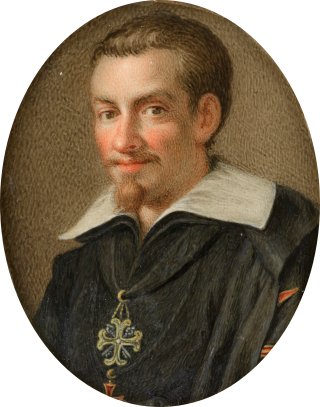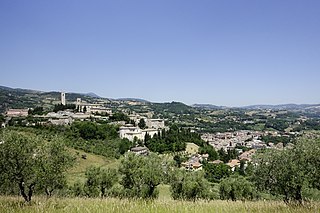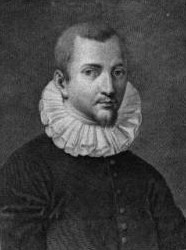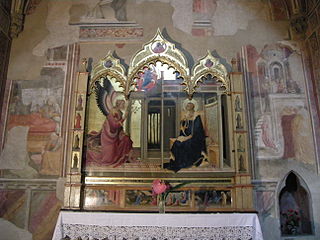
The Sienese School of painting flourished in Siena, Italy, between the 13th and 15th centuries. Its most important artists include Duccio, whose work shows Byzantine influence, his pupil Simone Martini, the brothers Pietro and Ambrogio Lorenzetti and Domenico and Taddeo di Bartolo, Sassetta, and Matteo di Giovanni.
Bellini is an Italian surname, formed as a patronymic or plural form of Bellino.

Lorenzo Monaco was an Italian painter of the late Gothic to early Renaissance age. He was born Piero di Giovanni in Siena, Italy. Little is known about his youth, apart from the fact that he was apprenticed in Florence. He was influenced by Giotto and that artist's followers Spinello Aretino and Agnolo Gaddi.

Ventura di Archangelo Salimbeni was an Italian Counter-Maniera painter and printmaker highly influenced by the vaghezza and sensual reform of Federico Barocci.

Francesco Vanni was an Italian painter, draughtsman, printmaker, publisher and printer active in Rome and his native city of Siena.

San Severino Marche is a comune (municipality) in the Province of Macerata in the Italian region Marche, located about 50 kilometres (31 mi) southwest of Ancona and about 25 kilometres (16 mi) southwest of Macerata.
The Battle of San Romano is a set of three paintings by the Florentine painter Paolo Uccello depicting events that took place at the Battle of San Romano between Florentine and Sienese forces in 1432. They are significant as revealing the development of linear perspective in early Italian Renaissance painting, and are unusual as a major secular commission. The paintings are in egg tempera on wooden panels, each over 3 metres long. According to the National Gallery, the panels were commissioned by a member of the Bartolini Salimbeni family in Florence sometime between 1435 and 1460. The paintings were much admired in the 15th century; Lorenzo de' Medici so coveted them that he purchased one and had the remaining two forcibly removed to the Palazzo Medici. They are now divided between three collections, the National Gallery, London, the Galleria degli Uffizi, Florence, and the Musée du Louvre, Paris.

Bonifazio Bevilacqua Aldobrandini was an Italian Cardinal. He was the uncle of Pope Gregory XIV.

Vincenzo Meucci (1694–1766) was an Italian painter of the late-Baroque period. Born in Florence. He was a pupil first of the painter Sebastiano Galeotti, then of Giovanni Gioseffo dal Sole in Bologna.

Rutilio di Lorenzo Manetti was an Italian painter of late-Mannerism or proto-Baroque, active mainly in Siena.
Bianchini is an Italian surname. Notable people with the surname include:
Events from the year 1568 in art.

Lorenzo Salimbeni and Jacopo Salimbeni were Italian painters. They were brothers whose work spanned both a relatively narrow geographical area and time period, from the triptych painting of the altarpiece of the Mystical Marriage of St Catherine by Lorenzo alone in 1400 to the frescoes of the Crucifixion and Scenes from the Life of St John the Baptist in the Oratory of St John the Baptist, Urbino, in 1416. The majority of their work is to be found in churches in and around their home town, San Severino Marche.

Lorenzo d’Alessandro was an Italian painter and interpreter of late gothic style. He is known by different authorities and authors by different names, including:
Lorenzo is an Italian and Spanish masculine given name of Latin origin. It is used in Italy, Spain, and other Spanish-speaking countries. The name was derived from the Roman surname Laurentius, which meant "from Laurentum". Laurentum, which is itself named after the laurel tree, was an ancient Roman city of Latium situated between Ostia and Lavinium, on the west coast of the Italian peninsula southwest of Rome.

The Bartolini Salimbeni Chapel is a chapel in the church of Santa Trinita, Florence, central Italy. Its decoration by Lorenzo Monaco, dating to the 1420s, are one of the few surviving examples of International Gothic frescoes in Italy. The chapel has kept other original elements, such as its altarpiece, an Annunciation, also by Monaco, and the railings.

The Bartolini Salimbeni Annunciation is a painting by the Italian Gothic painter Lorenzo Monaco, completed just before his death (1420–1424) and housed in the Bartolini Salimbeni Chapel of the church of Santa Trinita, Florence, Italy.
Arcangelo is a given name and a family name. Notable people with the name include:

Giovanni di Corraduccio, also called Giovanni Mazaforte, was an Italian painter of the Gothic style, active mainly in Umbria and Marche.

The Pinacoteca Civica Padre Pietro Tacchi Venturi is the civic art gallery of the town of San Severino Marche, region of Marche, Italy. Located at Via Salimbeni 39, it mainly displays sacred paintings from prior centuries.
This page is based on this
Wikipedia article Text is available under the
CC BY-SA 4.0 license; additional terms may apply.
Images, videos and audio are available under their respective licenses.













